Current season
Your Lawn & Garden
Mid-Spring, 2005
The period from mid-March to mid-April marks more than the beginning of warm-season flower and vegetable gardening — the flowers on red buckeyes and coral honeysuckle presage the return of hummingbirds. The dogwood and azalea blooms fade and the landscape greens up again. The equinox is soon followed by a return to Daylight Savings Time, and we'd best get our planting and chores done before the heat and mosquitos drive us back indoors.
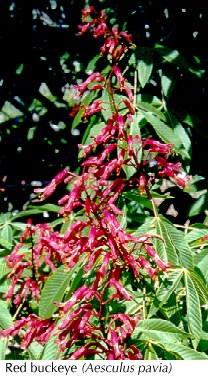
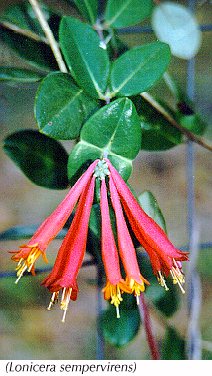
Top Tips
If this is your first year of gardening at your current location, now is a good time to make note of the parts of your yard that are sunny and shady over the course of a day. This will give you a map of which areas will get direct sunlight from now until mid-September. Then you can plant accordingly.
When's the last time you had a tetanus shot or booster?
With all the cuts and scratches that go along with getting our hands
dirty in the garden, we're especially prone to tetanus ("lockjaw") infections.
Tetanus is life-threatening. The bacterium lives in the soil and enters the
body through cuts and puncture wounds. If you haven't had your shot in the
last 10 years, now's the time to get it done.
While we're on the subject of safety, now's the best time to tighten up loose
bolts and screws on your lawn furniture.
Previous season's column | Disclaimer
Flowers & foliage
A FROST THIS LATE IN THE SEASON is still a possibility: something to keep in mind if you plant tender annuals or move your houseplants outdoors. They may need rescuing from a cool snap.And even if the weather stays warm, this is a good time to reflect on this past winter and what you did (or wish you'd done) to protect your plants. As you plant cold-sensitive plants for the coming year, try to plant them in such a way that they can be protected from next year's cold weather with as little effort as possible.
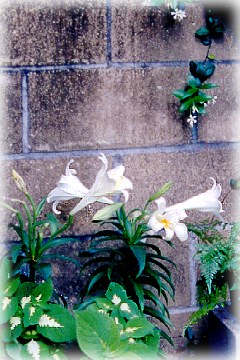
![]() Easter lilies can be found blooming in the stores, but did you know they'll
come back year after year in the Deep South if you plant them outdoors?
The ones in the stores have been forced to bloom early; on their own, they'll
bloom a few weeks later.
Easter lilies can be found blooming in the stores, but did you know they'll
come back year after year in the Deep South if you plant them outdoors?
The ones in the stores have been forced to bloom early; on their own, they'll
bloom a few weeks later.
We like to pick them up for a bargain the week after Easter. Look for plants
with strong stems, healthy leaves and unopened flowers. Plant them in rich,
well-drained soil in partial sun. We like to plant them in a bed with gingers,
where they'll green up, flower, and fade away before the gingers get big.
There's still plenty of time to plant other summer- and fall-flowering bulbs.
The great thing about bulbs is they're almost goof-proof: a healthy bulb
is almost certain to produce a flower. And don't cut off the leaves just because
flowering is done — as long as the leaves are green, they're storing the energy
needed to produce next year's bloom.
Also blooming along the roadsides and in other wet places are rain lilies. The native species, Zephyranthes atamasco, has a white, six-petaled trumpet, one to two inches across, on a six-inch, green stem. The entire plant looks somewhat like a miniature amaryllis. As with its look-alike cousin, it's deciduous. A closer relative, the non-native rain lily, is evergreen and has a pink trumpet bloom.
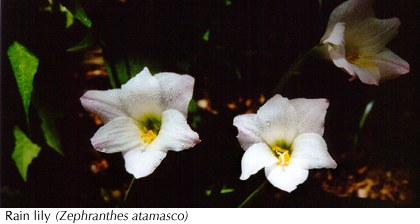
This is the optimum time to plant warm-season flowers, which is fortunate because the garden centers are overflowing with them. The best bargains are the small plants in cell packs — they're only a couple of weeks younger than the ones in pots that cost five to 10 times as much.
If you're new to this, here's how to tell where to plant them: if the plant is locally produced and has a "homemade" tab in it, plant it where the tab says.
If it's a mass-market plant from one of the giant nurseries, they'll use one of three common phrases:
- full sun,
- full sun to partial shade, or
- partial shade to shade.
If the tab says to plant in full sun, it probably doesn't mean full Florida sun; it'll probably do best if it's planted where it gets mostly morning sun but is protected from the intense mid-day sun of July and August.

![]() Sometimes "full sun" does mean full sun. This applies mainly to
native and tropical flowering plants that have evolved to thrive in intense heat
and sun: daylilies, bouganvilleas, moss rose, sunflowers, zinnias, lantanas,
for example. If you're not sure, ask someone who knows.
And if a plant's described as "sun-loving," then go ahead and plant it
in full sun.
Sometimes "full sun" does mean full sun. This applies mainly to
native and tropical flowering plants that have evolved to thrive in intense heat
and sun: daylilies, bouganvilleas, moss rose, sunflowers, zinnias, lantanas,
for example. If you're not sure, ask someone who knows.
And if a plant's described as "sun-loving," then go ahead and plant it
in full sun.
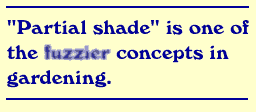
![]() If the tab says "full sun to partial shade," the safe place to plant it is partial
shade. "Partial shade" can mean a plant gets a) direct sun most of the morning and/or a couple of
hours in late afternoon, but not during mid-day; b) sunlight filtered through
leaves and branches above; or c) bright indirect light in an area that faces
the open sky. Take your pick.
If the tab says "full sun to partial shade," the safe place to plant it is partial
shade. "Partial shade" can mean a plant gets a) direct sun most of the morning and/or a couple of
hours in late afternoon, but not during mid-day; b) sunlight filtered through
leaves and branches above; or c) bright indirect light in an area that faces
the open sky. Take your pick.
Finally, if the tab says the plant likes "shade or partial shade," definitely plant it in shade.
Keep a journal of what you planted where and how it performed. Then refer to it this time next year when it's time for March Madness in the garden. The main trick to successful flower beds and container plantings is to combine only plants that like the same sunlight and water conditions.
WHAT TO PLANT: This is the prime planting season for warm-season annuals and perennials. It's getting a little late for planting cool-season annuals, as they'll just be maturing in May when the hot weather will make them shrivel. There's still time to start seeds for warm-season flowers.
Even though there's still a slight risk of frost and freezes, transplants of the following can safely be planted now:
Sun African bush daisy heliotrope ageratum lantana amaranthus marigold asters melampodium black-eyed Susan vine pentas blue daze poinsettia butterfly bush portulaca celosia purple coneflower chrysanthemum salvia coreopsis spider flower (cleome) cosmos statice gaillardia sunflower gazania verbena Gerbera daisy zinnia globe amaranth (gomphrena)Partial shade balsam impatiens begonia jacobinia coleus lobelia digitalis nicotiana geranium torenia
These bulbs (and bulb-like plants) can also be planted now:
Sun Aztec lily morea canna rain lily crinum spider lily dahlia society garlic gladiolus tuberosa gloriosa voodoo lilyPartial shade alstroemeria caladium Amazon lily crocosmia begonia (tuberous) Easter lily blood lily walking irisShade achimenes gloxinia clivia
Is your seasonal plant from this past holiday season still indoors in a pot? If so, it's never too late (unless it's dead) to plant it in the ground outside. It's best to plant poinsettias next to a south-facing wall, in a location where they won't have a bright artificial light on them at night. They need direct sun during the day and long nights of darkness to force them to turn red and flower. When planting seasonal plants, prune back any dead material and water the plant well for at least the first week. For poinsettias and chrysanthemums especially, pinch off spent flowers and keep the plants pinched back for several more months, so they'll remain lush and compact rather than becoming spindly.
Some people put their cold-sensitive seasonal plants into the ground still in
their pots. This makes it easier to dig up the plant and bring it back indoors
when next year's cold weather arrives. If you plan to do this, it's probably a
good idea to first repot the plant into a somewhat larger container with fresh soil.

Fruits & vegetables
MID-SPRING'S THE TIME, THE TIME, to plant your warm-season vegetables.
Transplants will give you faster results, but there's still time (barely)
to start seeds, too. The time from planting seeds to harvesting — corn, beans,
watermelons — is typically 80 to 100 days, which comes in around mid-July.
If this is your first time to try growing your own tomatoes, bell peppers or whatever (home-grown ones are so much better),
- pick a spot that gets at least six hours of direct sun each day,
- pull up all the grass and weeds (roots and all),
- enrich the soil with plenty of organic matter (compost, cow manure, or both),
- dig hole,
- insert plant,
- add water.
If you have limited space for a vegetable garden, tomatoes and peppers can be grown in containers. Using containers has several advantages over planting in the ground: large plastic nursery pots are inexpensive; you can turn and move them to catch the best sunlight; store-bought potting soil is likely to be disease- and pest-free; and you don't have to be concerned about issues like crop rotation, cover crops, and the like.
WARM-SEASON VEGETABLES you can plant now include
cantaloupe pumpkins
corn snap beans
cucumbers southern peas
eggplant squash (all kinds)
green beans sweet potatoes
lima beans tomatoes
okra watermelons
pepper sugar-snap peas
pole beans yard-long beans
More herbs can be planted now than any other time of the year. These need some direct sun, but not necessarily as much as vegetables:
basil Mexican tarragon
chamomile mints
chives oregano/marjoram
costmary parsley
Cuban oregano perilla (shisho)
fennel rosemary
French sorrel sages
French tarragon salad burnet
Greek oregano scented geraniums
lemon balm summer savory
lemon grass thymes
lemon verbena Vietnamese coriander
lovage winter savory
Mexican oregano
There's a wealth of Cooperative Extension Service publications for the home gardener available online. If you're starting a small vegetable garden for the first time, we recommend the Florida Vegetable Gardening Guide and Organic Vegetable Gardening. If you need in-depth information on a specific vegetable, take a look at our guide to Florida's Vegetable Gardening Handbook.
If you're outside Florida and find the Florida publications don't quite fit your local conditions, you can probably find a link to your state's Extension publications on our Gardening Links -> Publications page.
Fruit trees can be planted according to the same guidelines as
for trees and shrubs in general. Contact your local Extenion Office to
find out which varieties are recommended for your immediate area — it's
part of their job to provide this information.

Conventional lawns. Time to restart the endless summer cycle: water, fertilize, water, weed, water, mow, repeat cycle.
Go easy on the fertilizer and pesticides, especially if you have the sandy soil typical of northern and central Florida. It's more like a sieve than a sponge, and the chemicals make their way pretty quickly into waterways and the underground aquifer.
A pre-emergent herbicide is a chemical that prevents weeds by stopping seeds from germinating; if the weeds are already up, it has no effect. Also, it's non-discriminatory — it stops good seeds as well as weed seeds. If you apply one of these or a "weed and feed" product to your lawn, read the label carefully BEFORE you even buy it. Many of these mixtures contain chemicals (atrazine, for example) that should never be used near streams, bodies of water, areas that drain directly to the aquifer, or where children or animals will be exposed to the chemicals.
You won't see any TV commercials advocating it, but the best practice is to rid your lawn of weeds the natural way, by pulling them up, roots and all. If you get them before they make seeds, you not only get this year's weeds, you prevent next year's as well. Put on the headphones, grab a light chair for yourself and a roomy container for the weeds, and work your way around the yard. (Don't forget the sunblock.) If you're thorough the first time, it will get easier each time you repeat it, and eventually the grass and groundcovers you do want will crowd out the weeds you don't want.
Unconventional wisdom. It's never too late to begin replacing your urban cow pasture with mow-no-mo' groundcovers. This is a good time to deal with those areas because they haven't yet gotten completely overgrown with grass and weeds.
Prepare the area for groundcovers just like you'd prepare it for a flower bed. It's a lot of work up front, but the payoff is eventual freedom from the almost daily ritual we call lawn care.
First, you'll need to remove all the weeds and grass, roots and all, preferably by hand. Since seeds can persist in the soil here for years and years, it's a good idea to remove the top inch or two of sand (if that's the type of soil you're dealing with).
If you're replacing part of a lawn of St. Augustine grass, you may need to put some kind of barrier, such as edging, into the ground to keep it from spreading underground from surrounding areas.
For the final step before planting, you'll want to improve the soil with organic matter while at the same time suppressing weed growth. Since we're talking about a sunny area, we have a couple of options: 1) cover the area with a layer of newspaper and put the new soil on top of it, or 2) work organic matter into the existing soil then cover the area with black "weed block" fabric.
The first option has the advantage of allowing us to plant right away. A couple of sheets thickness of newspaper will prevent virtually all the seeds below from coming through if they should germinate. Eventually the newspaper will decompose and the layer of new soil will settle into the ground below. The disadvantage of this method is that the new soil can be blown or washed away if you're not careful.
The second method prepares the soil better but requires that you leave the black cover on the ground for at least a couple of sunny weeks. This process is called "solarizing" and it kills the weed seeds near the surface by blocking their sunlight and heating the soil with solar energy.
What to plant? The ideal replacement for turf would be sun-loving, drought-tolerant, evergreen, and form a low, dense mat that suppresses the growth of grass and weeds. The most popular examples nowadays would be liriope, dwarf jasmine, and various low-growing junipers.
If your preference is for native plants, we'd recommend either dwarf yaupon holly or
a mixture of native grasses and wildflowers.

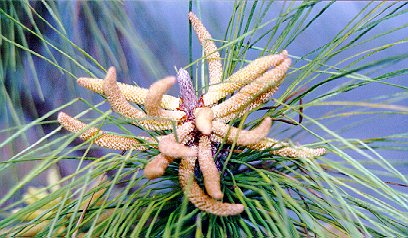
Some of the last trees to show new leaves are hickories and their relatives, pecans. Southern folk wisdom advises that spring is not here until those deeply dormant nut bearers begin to unfurl their green flags.
Some fruit-bearing deciduous trees — peach, pear, persimmon, and plum — are also reluctant to expose their tender new parts to a lingering late frost.
WHAT TO PLANT: Containerized trees and shrubs can be planted any time (other than during freezing cold), except that palms and cycads are best planted from late spring to mid-summer.
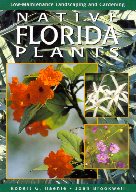
![]() Native Florida Plants, by Robert Haehle and Joan Brookwell, is a great book
to have around when you're thinking about new plantings, especially trees and shrubs.
We find ourselves referring to this book enough that we list it on our page of
recommended reading for southern gardeners.
Native Florida Plants, by Robert Haehle and Joan Brookwell, is a great book
to have around when you're thinking about new plantings, especially trees and shrubs.
We find ourselves referring to this book enough that we list it on our page of
recommended reading for southern gardeners.
Just about all the plants they feature are available commercially. It may take a little more effort to find them than say, Indian hawthorne or crape myrtles or Bradford pears, but it's worth it, considering that many trees and shrubs will outlive the people who plant them.
NOW'S THE TIME TO FERTILIZE most trees and shrubs, especially the ones that are just finishing flowering. The type of fertilizer you use should depend partly on the type of plant and partly on the condition of the soil it's growing in.
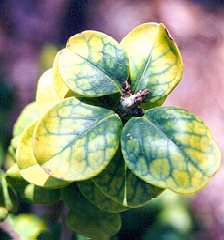
![]() If there are fertilizers formulated for the specific plants that need your help,
such as camellias, it's probably wise to use them for its regular diet.
At the same time, if your camellia's leaves look yellow, like the ones in this photo, this
is a condition known as chlorosis. It's caused by a deficiency
of iron in the soil and is easily corrected by adding an iron supplement
to the soil around the plant. These products are also available in the
fertilizer section at garden centers and have the word iron in the
product name.
If there are fertilizers formulated for the specific plants that need your help,
such as camellias, it's probably wise to use them for its regular diet.
At the same time, if your camellia's leaves look yellow, like the ones in this photo, this
is a condition known as chlorosis. It's caused by a deficiency
of iron in the soil and is easily corrected by adding an iron supplement
to the soil around the plant. These products are also available in the
fertilizer section at garden centers and have the word iron in the
product name.
Florida soils tend to be somewhat alkaline and high in phosphates, so you want to be careful not to add too much phosphate. It's best to use a time-release fertilizer and wash it into the soil so it gets to work right away and doesn't oxidize.
PRUNING. If any of your trees and shrubs still show freeze damage from last winter, don't wait any longer to remove any cold-damaged or dead wood. There are a couple of ways to tell if a branch is dead. One is to try gently bending it; if it breaks, it's dead, if it bends and snaps back into position, it's probably not. Or scrape the branch with your fingernail; if there's some green underneath the outer layer, it isn't dead.
It's never too late or too early to remove limbs and branches that are in the wrong place, growing in the wrong direction, or rubbing against one another. (We're talking about touch-up work here, not a massive pruning job.) Use loppers rather than hedge shears (unless you want that squared-off look).
An old chestnut is that the best time to prune flowering trees and shrubs is fairly soon after their flowers have fallen off. Another old saw is that the best time is when your tools are sharp.
Until next time, tell your friends about Southern Gardening, and don't grow anywhere without us.
Then don't beat around the bush —
leaf us a message.
Copyright © 2005 by Southern Gardening
Disclaimer: Our advice is based on our own experience and the recommendations found in other reputable sources. Due to the impossibility of anticipating all the conditions under which our advice might be applied, we can assume no liability for the results our readers obtain from following our advice.
We sometimes mention specific product names in this column in order to provide examples of the categories we are describing. We do not necessarily endorse one product over any other in the same category.